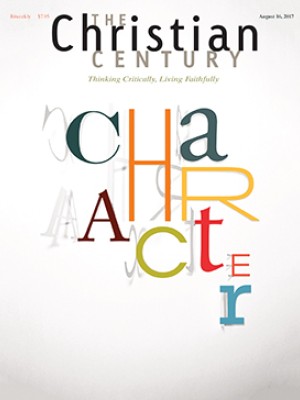Collars on the Corner offers prayers on the streets of Milwaukee
Ecumenical clergy reach their neighbors where they are—outside of church buildings.
As Luria Sampson drove to his daughter’s house in Milwaukee, his thoughts focused on her safety in a city suffering through a surge in shooting deaths in recent years. Then he saw an unexpected sight: a group of clergy dressed in black and wearing their collars standing on the sidewalk.
It is called Collars on the Corner, a public ministry that an Episcopal deacon and Roman Catholic deacon launched after a Milwaukee police shooting last August. The killing of a black man during a chase by an on-duty city officer, also black, sparked days of protests and thrust the city’s stark segregation into the national spotlight.
Read our latest issue or browse back issues.
Kevin Stewart, the Episcopal Diocese of Milwaukee’s missioner for community engagement, has spent much of the past year developing the ecumenical Collars on the Corner ministry with deacon Jim Banach of the Roman Catholic Archdiocese of Milwaukee. They invite clergy of all denominations to join them in collecting and responding to prayer requests, and they encourage churches to host the ministry on their own nearby corners.
Stewart and Banach teamed up last year after discussing their shared desire to connect with Milwaukee area residents in new ways.
“My understanding of scripture is Jesus spent more time out on the streets than [he] did in a building, so we felt that we should go,” Stewart said. “But go where, and do what?”
Now standing on this corner has become a routine Stewart repeats on Saturday mornings, as his schedule and the weather allow. They have found that people were hungry for personal and spiritual connection, Stewart said.
Over the winter, Stewart and Banach distributed prayer boxes across the Milwaukee area, and Stewart now collects prayer requests weekly from 25 locations, including seven congregations and 12 laundromats. He then sends them out to an expanding prayer chain by email and on Collars on the Corner’s Facebook page.
“To maintain my sobriety,” reads one prayer request. Another asks for prayers “for my family’s safety and happiness. I also ask you to pray for my strength to overcome things that bring me down.”
The collars returned to the corners in the spring, with prayer request stations set up in several locations and at multiple antiviolence events. While Stewart and Banach work to involve more churches, they maintain a regular presence at Center and 51st, their unofficial home base.
“The beauty of it is we’ve already got some friends in the neighborhood,” Banach said. “They see us out here and they come running.”
On one Saturday, the corner where the clergy were standing also included a card table with a box for written prayer requests.
“We’d be happy to pray with you right here and now,” Stewart told Sampson as he approached.
“Yes, please do,” Sampson replied. “I could use a good prayer.”
Anthony Luckett, of the nondenominational Saint Paul Church, called on God to bless Sampson and his family and give him strength as he spreads his compassion to those around him.
Some of the foot traffic on this corner is generated by St. Catherine’s Saturday food pantry. Jacqueline Garcia, 46, said she stops by the food pantry once a month, but this was her first time seeing the prayer request station.
She and her friend, Micha Jones, 38, each scribbled their prayers on paper and put them in the box. Then, over the sound of cars cruising by on Center Street and the drone of a lawnmower, they prayed with the clergy.
Jones said she sometimes attends church services but not regularly. That tenuous connection to a physical church is common among people here, but the goal of Collars on the Corner isn’t to fill the pews. Stewart recalled welcoming someone on the corner who feared going back to church. The person had been away “too long” and had “done too much wrong.”
“Maybe that person will walk inside a church door again, we don’t know,” Stewart said. “But on that day, the church was out here meeting people where they’re at.” —Episcopal News Service





